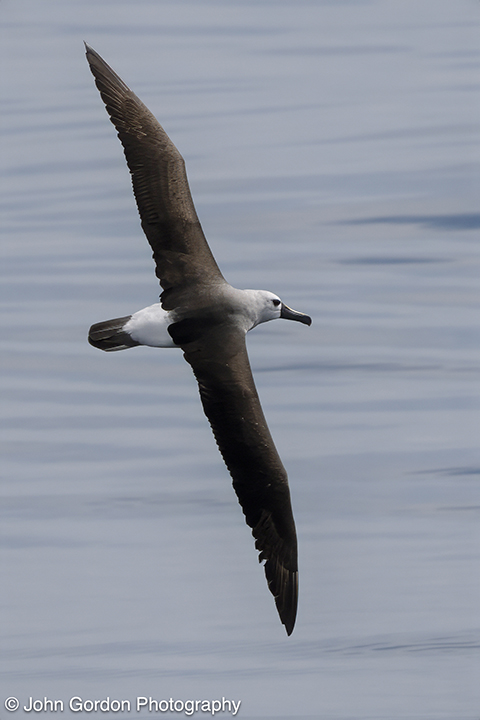Costa Rica Birding Trip
February 18 to March 5
Story Scott Mackay/Photography John Gordon
Costa Rica is a small country and drive time from the Pacific coast to the Caribbean coast is roughly four hours. From northern border to southern border is eight to ten hours. If including a drive through San Jose add an hour or more. There are nine hundred plus bird species in Costa Rica. In the lists of birds viewed I have tried not to repeatedly mention the more common species. A total of three hundred and fifteen species were viewed. No heard birds were added to our list.
Day 1: San Jose, Central Valley
The male Montezuma oropendola performs an elaborate courtship display where it sings and swings by its feet. The tail is described as a golden pendulum, earning it the Spanish name "oropendola".
 |
| A Montezuma's Oropendola swings forward before returning to an upright position. |
Departing from different locations, we met up at Mexico City and then flew to San Jose, arriving mid-day February 18. Adobe Car Rentals supplied us with a Suzuki Vitara 4WD and we drove to Hotel Bougainvillea, 20 minutes north of the airport. There are plenty of birding opportunities in the 10 acre botanical garden at the hotel and our species list included: Gray-headed Chachalaca, Rufous-tailed Hummingbird, White-tailed Kite, Tropical Screech-Owl, Lesson’s Motmot, Lineated Woodpecker, Orange-chinned Parakeet, Common Tody-Flycatcher, Social Flycatcher, Brown Jay, Rufous-backed Wren, Wood Thrush, Clay-colored Thrush (National Bird of Costa Rica), Baltimore Oriole, Great-tailed Grackle, Yellow Warbler, Blue-gray Tanager, Bananaquit, Cinnamon Saltator, Red-billed Pigeon, White-winged Dove, Great Kiskadee, Montezuma Oropendola and a resident Mottled Owl. Hotel Bougainvillea is highly recommended most notably for its gardens.
Day 2 & 3: Tarcoles/Hotel Cerro Lodge/Carara National Park
The drive to Hotel Cerro Lodge/Carara National Park involves negotiating the roads of San Jose (navigation apps Wayze and Google Maps) some four lane highways, several toll booths (cash or credit card) and a trip length of roughly 1.5 to 2 hours. The lodge is located off the highway on Calle La Barca a road that we birded on our way to check in. A quick lunch on the veranda watching the fruit feeding station gave us Scarlet Macaws, tanagers, warblers and saltators before we did a quick exploratory visit to Carara National Park. A rapidly appearing downpour reminded us to keep our rain gear handy. Birding was slow but we were now prepared for the morning. Note: Passports and a fee are often required for park admittance.
 |
| This Orange-collared Manakin was on a lek with female close-by. |
The next morning Carara was open at 7 a.m. and with our guide we hiked the lush jungle environment of this South Pacific Slope park. We compiled a fairly comprehensive list of species including: Crested Guan, Northern Black-throated Trogon, Chestnut-backed Antbird and Gray-headed Tanager. Hummingbirds included Rufous-tailed, Long-billed Hermit and Purple-crowned Fairy. A close-up of a Spectacled Owl allowed for great photos.
 |
This Spectacled Owl was being mobbed by a mixed flock.
|
The humid jungle also gave us Lesson’s Motmot, White-whiskered Puffbird, Barred Antshrike, Dusky and Chestnut-backed Antbirds, Black-faced Antthrush, Wedge-billed and Cocoa Woodcreepers, Velvety and Orange-collared Manakins, the latter at a Lek, Rose-throated Becard, Eye-ringed Flatbill, Streaked Flycatchers, Tropical Kingbirds, Summer Tanager, Blue Grosbeak and flocks of noisy Red-lored Amazons.
 |
| Rio Tarcoles boat trip is best taken at high tide. |
 |
| A immature Bare-throated Tiger Heron hunts on the Tarcoles River. |
 |
| Yellow-naped Amazons are rated as critically endangered. |
A boat exploration on Rio Tarcoles revealed a Semipalmated Plover, Whimbrels, Spotted Sandpipers, Willets, Western Sandpipers, a Wood Stork, numerous Magnificent Frigatebirds, Anhingas, Neotropic Cormorants, White Ibis, Roseate Spoonbill, Bare-throated Tiger-Heron, Boat-billed Heron, Yellow-crowned Night Heron and several Black-crowned Night Herons. We were entertained by Spider Monkeys and White Faced Monkeys in the canopy.
 |
| A member of the racoon family, White-nosed Coatis often travel in family groups. |
A late afternoon ramble around our guide’s home town of Tarcoles proved to be a winner. He found us a pair of Laughing Falcons close enough for John to get some great shots. We also found Inca, Ruddy Ground, White-tipped and White-winged Doves, several of the humorous Groove-billed Anis, a flock of Lessor Nighthawks, White-collared Swifts, a Costa Rican Swift, Double-striped Thick-knee, Common Black Hawk, Gray Hawk, two Ferruginous Pygmy Owls, a Black-headed Trogon, Gartered Trogon, Turquoise-browed Motmot, Green Kingfisher, Hoffman’s and Pale-billed Woodpecker. Scarlet Macaws are plentiful in this area and we also saw Red-lored, Yellow-naped, and Mealy Amazons. Flycatchers were abundant including: Common Tody, Northern-scrub, Panama, Social, Streaked, Tropical, and Great Kiskadee and Prothonotary Warbler.
 |
Prothonotary Warbler, a lifer.
|
Lastly we could list a Northern Tropical Peewee, Philadelphia Vireo, and Rufous-backed Wren. Two days of guided birding rewarded us with 102 species, most of them unique and fascinating. Birding-specific lodges in the area include Hotel Cerro Lodge, Tarcol Lodge and Hotel Villa Lapis.
 |
| Double-striped Thick-knee in a farmers field. |
 |
| Cinnamon Becard. |
 |
Scarlet Macaw.
Due to very low light conditions I decided to pan or follow the macaw as it flew from one tree to another. |
 |
| The Streaked Flycatcher was a target bird. |
Day 4 & 5 Monteverde/Curi Canche/Monteverde Cloud Forest Reserve
On the road at 6 a.m. with a quick drive to the lower elevation end of Calle La Barca, where we birded the pastures. There was a stunning number of Scarlet Macaws displaying their incredibly colourful feathers in large groups flying from tree to tree. Macaws are a large gorgeous bird that is really impressive when seen in numbers. We pointed the car in the direction of Monteverde/Santa Elena and with several short stops for birds and some delightful Costa Rican coffee. After a three hour drive we arrived at Hotel Don Taco in Santa Elena. (The Don Taco was the most reasonably priced stay on our tour and had exceptional pizza. Seriously!) The road (Ruta 606) from Carretera 1 to Monteverde is absolutely beautiful if rather curvy with precipitous drops into verdant valleys. We headed to Monteverde Cloud Forest Reserve, a 12,000 acre park straddling the continental divide and spent an hour watching the hummingbird feeders at the gift shop outside of the park.
 |
| Olivaceous Woodcreeper with a caterpillar. |
 |
| Agoutis were easily spotted both in the wild and around lodges where they could find easy pickings. |
 |
| Yellow-faced Grassquit feeding on grass seeds. |
 |
| Resplendent Quetzal (male). |
Ancient Aztec and Maya regarded the Resplendent Quetzal's bright feathers as objects of power, beauty and adornment. Quetzals are threatened by habitat loss, but many now live safely in protected cloud forests of Central America where they are beloved by bird watchers. (AI)
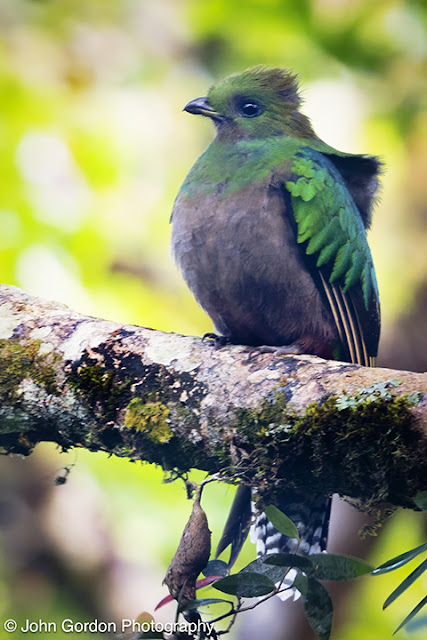 |
| The Resplendent Quetzal (female) takes a more subtle approach. |
Species seen: Green Hermit, Lesser Violetear, Green-crowned Brilliant, Purple throated Mountain-Gem, Magenta-throated Woodstar, Violet Sabrewing, Stripe-tailed Hummingbird, plus a Southern House Wren and a Black Guan. After consulting with our guide it was decided to bird Reserva Curi Cancha at first light. Only 50 people at a time are allowed in the reserve, keeping it quiet and calm. It has primary and secondary forest, borders the Cloud Forest Reserve, sits at between 4750 feet and 5,300 feet elevation, and boasts of resident Resplendent Quetzals.
 |
| Collared Trogon, one of forty-seven species of trogon in seven genera. |
Other species seen: Yellow-faced Grassquit, Silver-throated Tanager, Golden-crowned, Chestnut-capped, and Golden-winged Warblers, Chestnut-capped Brushfinch, Common Chlorospingus, Mountain Thrush, Rufous-and-white and Ochraceous Wrens, Yellowish Flycatcher, Mountain Elaenia, Red-faced Spinetail, Streak-headed and Olivaceous Woodcreepers, White-fronted Amazon, Smoky-brown Woodpecker, Slaty Antwren, Resplendent Quetzal, Bicolour Hawk, Coppery-headed Emerald and Ruddy Pigeon. Before entering the reserve we detected a Collared Trogon, Golden-olive Woodpecker, Northern Emerald-Toucanet, and a Blue-vented Hummingbird along the roadside.
Day 6 San Luis Finca Ecologia/Depart to La Fortuna/Arenal Volcano
We were up at 5 a.m. and headed to the San Luis-Finca Ecologica in the San Luis Valley. The valley is nicknamed the Rainbow Valley due to the enormous amount of moisture that moves from the cloud forest into the neighbouring valleys, creating brilliant multi-coloured skies and spectacular rainbows.
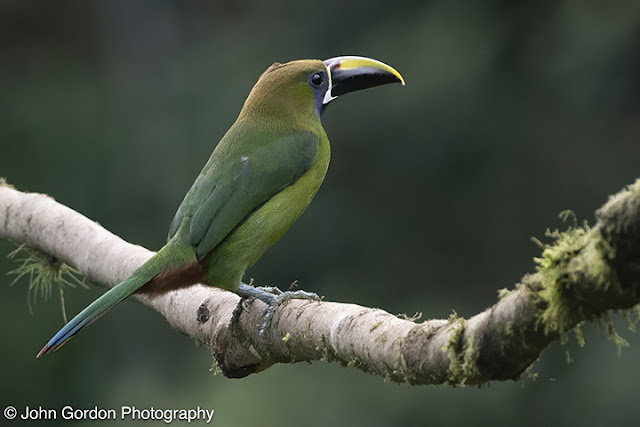 |
| Emerald Toucanet, one of six species of toucan found in Costa Rica. |
 |
| Brown Violetears can be found at middle elevations. |
 |
| Chestnut-colored Woodpecker is found on the Caribbean slopes of Costa Rica. |
On the fruit (bananas grown on the finca) and feeders at Finca San Luis we saw: a Buff-throated Saltator, Blue-gray, Scarlet-rumped, and Crimson-collared Tanagers, Melodious Blackbird, Baltimore Oriole, Yellow-crowned Euphonia, Boat-billed Flycatcher, Masked Tityra, White-fronted and Brown-hooded Parrots, Great Black Hawk, Lesson’s Motmot, Squirrel Cuckoo, and Gray-headed Chatchalaca. A brief stop at Bajo del Tigre yielded a White-eared Ground-Sparrow and a Chestnut-capped Warbler but not the Manakins we were hoping for.
 |
Widespread throughout Central America.
Yellow-throated Euphonia is member of the finch family.
|
A re-fuel for the car and we were off to the Arenal Volcano/La Fortuna area. The area around the volcano is considered part of the Caribbean Middle Elevations. This was our longest change of location which was made slightly longer due to John discovering on Google Maps that our route was blocked by a landslide. A timely discovery, a mistake would have set us back by hours during the reversal. Our mid-afternoon arrival in La Fortuna meant a little time for a refreshing beverage, taking in the awe-inspiring view of the Arenal Volcano and then birding around our lodging. Around Arenal Roca Lodge we found: Western Cattle Egrets, Yellow-throated Toucans, a Lineated Woodpecker, Common Tody Flycatcher, Tropical Kingbird, Brown Jay, Blue and White Swallows, Yellow-throated Euphonia, Rufous-collared Sparrow, Chestnut-sided and Yellow Warblers, Scarlet-rumped and Blue-gray Tanagers, and a Thick-billed Seed-Finch.
Day 7 & 8 La Fortuna/Arenal Volcano
We were fortunate to have obtained a highly regarded guide who had been referred to us. Antonio was as advertised! He recognized every bird he heard, and spotted birds in the thickest of vegetation. He directed us to several productive areas including the road leading to the Arenal Observatory Lodge, and the lodge feeders and trails. This area is recognized for its variety of bird species as our list will attest. On the road to the lodge we saw: Green Honey creeper, Golden-hooded Tanager, Red-throated Ant-Tanager, Buff-rumped Warbler, Giant Cowbird, Olive-backed Euphonia, Bay and Nightingale Wrens, Lesser Greenlet, Piratic, Olive-streaked and Gray-capped Flycatchers, Long-tailed Tyrant, Northern Plain-Xenops, Black-cheeked Woodpecker, Amazon Kingfisher, Roadside Hawk, Southern Lapwing, Scaly-breasted Hummingbird, Gray-rumped Swift, Chestnut-headed Oropendola, Orange-billed and Black-striped Sparrows, Fawn-throated Foliage-gleaner, Thicket Antpitta, Swallow-tailed Kites, and a Great Curassow.
 |
| Swallowtail Kites hunt on the wing for insects but will also swoop down to take lizards and small mammals. |
 |
The Great Curassow were once hunted but newly enacted hunting laws have seen their numbers rebound.
|
 |
| A Green-fronted Lancebill was found beside a creek, its prefered habitat. |
Many of those were lifers for us, but more prizes were to come at the lodge. There we saw: Scarlet-thighed Dacnis, Emerald, Palm, Carmiol’s, Black-and-yellow, Bay-headed Tanagers, and White-throated Shrike-Tanagers, Tawny-capped Euphonia, Pale-vented Thrush, White-breasted, and Stripe-breasted Wrens, Tawny-crowned Greenlet, Rufous, Mourner, Mistletoe Tyrannulet, Scale-crested Pygmy-Tyrant, Sulphur-rumped Flycatcher, White-ruffed Manakin, Spotted Woodcreeper, Spotted and Dull-mantled Antbirds, Streak-crowned Antvireo, Broad-billed Motmot, Violet-headed Hummingbird, Black-breasted Coquette, Brown Violetear, Blackburnian and Tennessee Warblers, Cinnamon Becard, White-throated Parrot, Rufous-winged Woodpecker, White and Barred Hawks, Green-fronted Lancebill, Ornate Hawk-Eagle and Crowned Woodnymph.
 |
| A Sunbittern hunts for small fish near the Arenal Observatory. |
 |
| A White Hawk dries itself off after a rainstorm. |
A long list to be sure, but we then changed location to a gravel road near the dam on man-made Lake Arenal. Here we saw: Yellow-bellied Elaenia, Mourning Warbler, Black-throated Wren, Long-billed Gnatwren, Southern Rough-winged Swallow, Yellow-bellied and Black-headed Tody Flycatcher, Yellow Tyrannulet, White-collared Manakin, Bare-crowned Antbird, Great Antshrike, Rufous-tailed Jacamar, White-fronted Nunbird, Keel-billed Motmot and Pale-vented Pigeon. Loud booming dog-like barks was heard from a group of Howler Monkeys. On the lodge access road, the river yielded a Sunbittern and a White-necked Jacobin.
 |
| Long-tailed Tyrant. |
 |
| Julia Heliconian (Dryas iulia) |
 |
Golden-winged Warbler.
The majority of the global population breeds in Wisconsin, Minnesota, and Manitoba. |
Day 9 & 10 La Selva Biological Station
On the road by 5:45 a.m., we made the short drive to La Selva in one and a half hours, allowing us to join the 8 a.m. guided tour of the facility. La Selva is a member of the Organization for Tropical Studies, a consortium of over 60 universities around the world. It contains 4,000 acres of lowlands forest and over 2,000 plants have been identified in the area. La Selva is located in the Caribbean Lowlands. The introductory tour produced a Black Hawk Eagle, Yellow-throated Toucan, Black-faced Grosbeak, White-browed Gnatcatcher, Rufous Motmot, Crested Owl, Semiplumbeous Hawk, and a Hook-billed Kite.
 |
| The Black-faced Grosbeak is member of the cardinal family. |
The accommodations at La Selva are rather spartan but sufficient and clean. The benefits however, are being on site, and cafeteria style meals that are available at very reasonable prices. The station houses students taking courses and scientists doing research.
 |
Yellow-throated Toucans are threatened by loss of habitat
due to farming and de-forestation. |
The morning birding was very slow. Our guide explained that the dry season (December through April) was wetter than usual and thus producing more fruit, flowers, insects and other foods, keeping many birds deeper in the jungle. We did see a Chestnut-coloured Woodpecker and Gray-chested Dove as well as numerous peccaries.
 |
Hook-billed Kite, a widespread raptor of the tropics.
|
 |
Semiplumbeus Hawks tend to hunt low to the ground,
scouring the forest floor for prey. |
Monkey Business
 |
A Howler Monkey checks out Scott and I.
|
A pedestrian suspension bridge over a river ravine proved to be a draw for Howler Monkeys and a Three-toed Sloth. Leaf–cutter Ants abound and of the many types of ants here, the Bullet Ant is considered the most dangerous. They are about one inch (2.5 cms) in length and its bite is considered extremely painful. The Fer De Lance, a venomous pit viper also makes its home at La Selva.
Day 11 & 12 Hotel Quelitales
Our drive to Hotel Quelitales takes slightly over three and a half hours due to slow traffic in the hills just north- east of San Jose and then the drive through busy congested San Jose. Once through the city we began to enjoy the beautiful hills and valleys of the middle elevations of the Caribbean Slope. The towns of Paraiso and Turrialba are located in this area and our destination was at the end of a road beyond the village of Cachi. Hotel Quelitales owner Jose welcomed us and offered to guide us for the afternoon. His knowledge of the birds and the exceptional flora of his property was excellent.
 |
| A fast shutter speed of 1/2000 sec was needed to capture this Green Thorntail feeding. |
 |
| The White-crowned Parrot has become locally extinct in parts of its range, likely as a consequence of extensive deforestation (BirdLife Date Zone). |
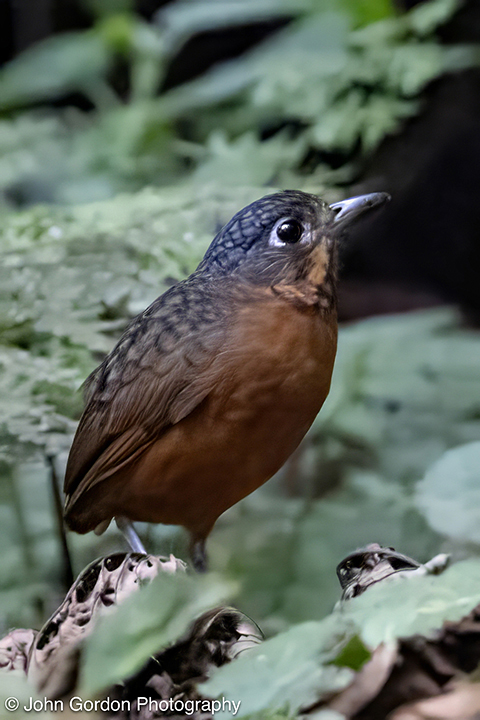 |
It was almost dark when this Scaley Antpitta appeared out of the forest.
It stayed for all of fifteen seconds. |
During an afternoon and the next morning trips we saw Elegant and Tawny-capped Euphonia, Common Chlorospingus, Southern House Wren, Black Guan, Slaty-backed Nightingale-Thrush, Gray-headed Chachalaca, Red-billed Pigeon, Green Thorntail, Green-crowned Brilliant, White-bellied Mountain-Gem, Violet Sabrewing, and Rufous-tailed Hummingbird. A Sunbittern and Green Ibis were spotted in the pond. Hoffman’s Woodpecker, Brown-hooded and White-crowned Parrots, Streak-headed Woodcreeper, Cinnamon Becard plus Common and Black-headed Tody-Flycatchers were observed in the hills. Others of interest included: Slate-coloured Redstart, Rufous-collared and White-eared Sparrows and Blue-and-white Swallows. Top marks to Jose and Hotel Quelitales for an excellent restaurant, good lodgings and a beautiful property.
Days 13 & 14 Rancho Naturalista
Wanting to meet our next guide at 8 a.m., we were on the road at 5:45 a.m., enjoying a truck-free and scenic Ruta 425. We made it to Rancho Naturalista in one hour. Perched on a hill-side of the Caribbean Slope in the central mountains, this birder’s inn is a delight.
 |
| Insects make up a large portion the White-necked Jacobins diet. |
The staff is top-notch, super friendly and the three meals that are included in the pricing are excellent. When we arrived breakfast was waiting as were the birds at the feeders. Our guide was Mercedes. She is a skilled birder with extensive knowledge about the flora and fauna of Costa Rica and her enthusiasm was infectious. Our huge list of species viewed included numerous hummers: Stripe-throated Hermit, Green-breasted Mango, Black-crested Coquette, Violet-headed, Violet Sabrewing, Bronze-tailed Plumeleteer, Crowned Woodnymph, Rufous-tailed and the big prize…Snowcap. On the trails we saw Lesson’s and Rufous Motmots, Blue-cheeked and Smoky-brown Woodpeckers, White-crowned Parrot, Crimson-fronted Parakeet, Cocoa and Spotted Woodcreepers, Fawn-throated Foliage-gleaner, Gray-capped, Tawny-chested and Slaty-capped Flycatchers, Cinnamon Becard, Yellow-olive Flatbill, Black-crowned Tityra, Yellow-bellied Elaenia, Mistletoe Tyrannulet, Philadelphia Vireo, Blue-and-white Swallow, White-browed Gnatcatcher, Bay Wren, Wood, Yellow-crowned, White-vented, Yellow-throated, and Olive-backed Euphonia, Black-striped and Orange-billed Sparrows, Chestnut-sided and Blackburnian Warbler, Buff-throated and Black-headed Saltators, and Gray-cowled Wood-Rail.
 |
| The Lattice-tailed Trogon is found in both Costa Rica and Panama. |
 |
| Purple-throated Mountain Gem. |
Rancho Naturalista is about one hour’s drive from El Copal Biological Reserve. Described in Barrett Lawson’s “A Bird-Finding Guide to Costa Rica”, as “one of Costa Rica’s best kept birding secrets”, we were once again on the road before sun-up, this time to El Copal. The reserve is privately owned and was closed for a holiday, but our guide’s reputation allowed us to enter and have the luxury of the reserve to ourselves. With clouds smothering the tops of the mountains surrounding the valley we wandered the trails to see new listers: Song Wren, Rufous-browed Tyrannulet, Ochre-bellied Flycatcher, and Lattice-tailed Trogon. With this visit being close to Rancho Naturalista and at the very end of two weeks of intense birding, we had numerous duplicate sightings. However, within that list was: Stripe-headed Hermit, Snowcap, Keel-billed Toucan, Black-cheeked Woodpecker, Olivaceous and Wedge-billed Woodcreepers, White-ruffed Manakin, Dusky-capped, Social, Gray-capped Flycatchers, Chestnut-sided and Chestnut-capped Warblers, Green Honeycreepers, Scarlet-thighed Dacnis, and 11 Tanager species. We heard but could not locate a Three-wattled Bellbird that was singing in a nearby treee.
Photography Notes:
Unfortunately the bird feeding station at El Copal was not positioned for early morning photography. It would have been perfect in the late afternoon. The sun was behind the birds and in my face which made photography very difficult. Check with your guide to avoid disappointment and perhaps re-arrage the time of day for a visit. Here are two shots that barely made the cut, most I deleted. The backgrounds are great but I had to do quite a bit of post processing which I prefer not to do. (John)
 |
| Red legged Honeycreeper (female) |
 |
| Speckled Tanager |
Photographing in the rainforest can be challenging. Sudden downpours, high humidity and especially low light meant pushing the camera to its limits. Some of these images were taken with ISO 6400 and a few at ISO 12,800.
All photographs Nikon Z8 and 500mm 5.6 PF lens.
The next day we headed back to San Jose for one last night and then home. We stayed at Hotel Robledal. We had twenty species in the hotel grounds plus John found a lifer, a Spot-breasted Oriole. The perfect ending to our two week trip to Costa Rica.
 |
| Spot-breasted Oriole picks at a spider's web. |
Costa Rica is a sensational country to go bird watching. The small size of the country allows for short drives between locations. There is a large supply of birding specific lodgings, and super guides. Nature guide licensing is a two year process after years of knowledge gaining on the trails of this beautiful country. The local folks are friendly, helpful and appreciative of tourism’s benefits to their livelihood. Thank you Costa Rica.
Reference books used:
The Birds of Costa Rica-A Field Guide by Richard Garrigues and Robert Dean.
A Bird-Finding Guide to Costa Rica, /Barret Lawson
Costa Rica Trip Report
"It's never too late to keep on travelling"
John Gordon
Langley/Cloverdale
BC Canada
























































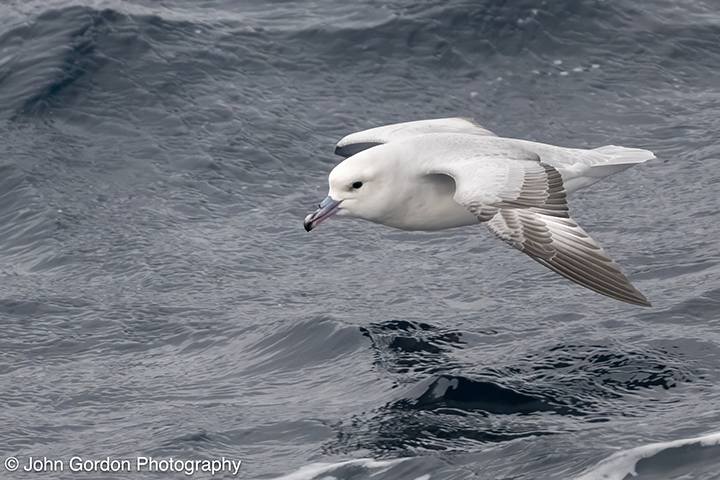



-3018.jpg)





